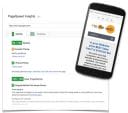Simple Data-Driven Strategies to Fast-Track Lead Generation

Effective marketing strategies begin with the end in mind—the goal.
Successful websites perform a simple and critical role for your company: they generate leads.
In this post, I will break down the website lead generation process to its simplest form, and share four approaches that focus on website analytics that will fast-track your lead generation efforts.
→ Download: The data drive approach to fast-track B2B demand gen.
Lead generation one, two, three
You’re familiar with the classic sales funnel. Some call it the “buyer’s journey.” And there seems to be a movement afloat to complicate it. The digerati, especially from the marketing automation camp, claim with the buyer in charge the journey southward down the funnel is entirely unpredictable.
Maybe so, but even though prospects come and go, there’s great power in simplifying the process of website conversion into three essential actions.
- Drive traffic—New visitors come to your site, largely via search
- Engage—A level of interest is reflected by some form of engagement
- Convert—The buyer becomes a legitimate prospect via a conversion action
If your website is equipped to capture leads, to some degree the trio of actions above happen. However, to a greater degree, they don’t. So what’s the plan?
Understand bounce, click-through, and conversion metrics
Again, we’re keeping this simple. A simple examination of your Google Analytics is likely to reveal the majority of your new visitors enter your site by way of the homepage. So I submit the process of improving conversion relies on tackling three essential analytical elements:
- Homepage bounce rate—Percentage of visitors that leave without clicking a subsequent page
- Click-through to key sales pages—Product, services, demos, trials
- Conversion Rates—Percentage of visitors that perform the desired action
Rarely do our clients (most of which are in the software business) pay attention to these critical “website health factors” as they should.
→ First, get your analytics in order
Your Google Analytics must be set up and configured correctly or you’re bound to collect faulty data. Having your webmaster paste in a snippet of code is only the beginning of the analytics implementation process. Analytics has become more complex in recent years due to:
- Cross-device tracking
- Subdomains
- Event tracking
- Remarketing
- Goal setup
Typically, webmasters will require help with some or all of the above. Check out these resources:
- iDimension offers an excellent analytics audit.
- Google Analytics Implementation Guide
- Google Analytics Help Center
Example of Homepage Bounce Rate Problem

Four approaches to website #analytics that will fast-track your lead generation efforts. Click To Tweet
→ I’m going to boil it down to the major issues that demand your attention.
Eliminate bad data.
A sizable portion of your homepage traffic isn’t human; it’s search bots. I’ll spare you the explanation why, but tell you with a little bit of Google Analytics know-how you can identify the culprits and extract them from your data collection to arrive at the accurate numbers you need.
A variety of factors and analytics baggage also negatively affect both your bounce rate and your data regarding it—for instance, page views by employees. Or, marketing campaigns that are not set up correctly. That’s why we created this handy tool to help you create your campaign tracking URLs correctly.

Understand the user experience.
What you need to know (and likely don’t) is what does and doesn’t get clicked on your homepage. Heat mapping tools make this step do-able. I’m fond of the Crazy Egg product and use it on all my clients’ sites. (Google Analytics In-Page Analytics reporting does not work correctly without a lot of additional coding)
Crazy Egg heat maps reveal clicks to uncover composite data from real user experiences.
Fix speed issues.
 The time it takes for your homepage to load is (1) a ranking factor and (2) can be a major contributor to your bounce rate. Again, tools come into play. Free and more sophisticated paid tools will identify the slugs, so you can create an action plan to promptly resolve slow load issues.
The time it takes for your homepage to load is (1) a ranking factor and (2) can be a major contributor to your bounce rate. Again, tools come into play. Free and more sophisticated paid tools will identify the slugs, so you can create an action plan to promptly resolve slow load issues.
- Google’s free Page Speed Test tool reports issues you can fix to improve load times.
- GTmetrix offers a free and paid speed testing tool to regularly monitor your site speed.
I delve deeper into this in the following presentation: Data-Driven Strategies to Fast-Track Lead Generation
→ Do visitors see what you sell?
You can’t sell to people who are never shown your solutions. In other words, you need to evaluate how well your homepage does or doesn’t inspire visitors to click-through to your products pages—where you make an offer of some type such as try and/or buy.
Your homepage needs to serve as the launchpad for a conversion path because visitors don’t buy from the homepage. So if your products pages are not among the most visited on your website, you need to identify why and test alternative approaches.
Tip: Offer a link to “Pricing” from the homepage and it will be one of the most clicked elements on the page. Pricing for B2B sites – often with long sales cycles – can be as simple as “Pricing starts at $xxx. For more information request a demo.”
→ Where are your buyers coming from?
Again, Google Analytics must be set up correctly. Here, I’m talking specifically about goal tracking—a powerful feature that’s too often ignored.
The data you need to uncover is the specific traffic sources driving conversions (LinkedIn, Partner sites, etc). Armed with these analytics, you can take meaningful actions:
- Increase activity from a high-performing channel
- Experiment with a new approach for a low-performing channel
- Reduce or eliminate time spent on the stinkers
- Improve landing pages and/or conversion paths
- Change your offers
Generally, we expect direct and organic search traffic to drive respectable conversion rates. What about the others? Progressive online marketers often employ a variety of channel strategies… social media… PPC, guest blogging, Wikipedia and LinkedIn.
The key is to understand what converts, which of course, comes from the data. And therein lies the entire point of this post. Data-driven strategies improve traffic, leads and sales.
Put the pieces in place and it all starts to click.
Rosemary Brisco
AI Training Videos
AI Consulting and Training
Master today’s most effective productivity tools.
ToTheWeb ensures your route to capitalizing on the immense power of AI is fast and efficient. Our AI consulting and training programs will quickly enable your marketing team to adopt solutions to optimize operations and boost performance.
Learn about our generative AI and ChatGPT consulting and training programs



